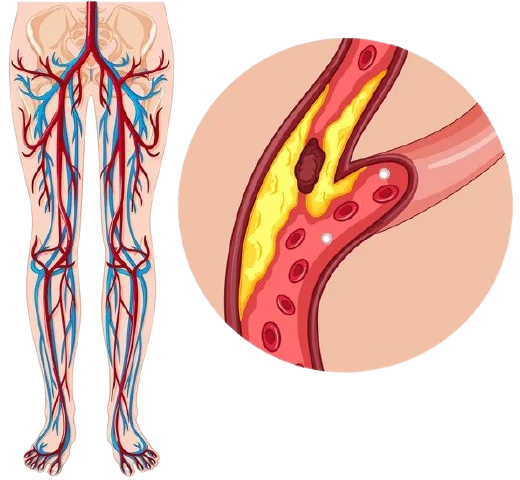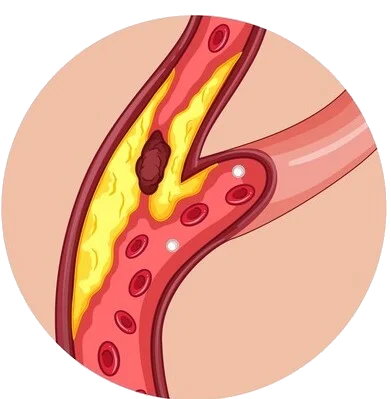Book Your Appointment
Peripheral Artery Disease (PAD)
Get At Swasthyam Superspeciality Hospital
Peripheral Artery Disease (PAD)
Peripheral artery disease (also called peripheral arterial disease) is a common circulatory problem in which narrowed arteries reduce blood flow to your limbs.
When you develop peripheral artery disease (PAD), your legs or arms — usually your legs — don’t receive enough blood flow to keep up with demand. This may cause symptoms, such as leg pain when walking (claudication).
Peripheral artery disease is also likely to be a sign of a buildup of fatty deposits in your arteries (atherosclerosis). This condition may narrow your arteries and reduce blood flow to your legs and, occasionally, your arms.
You often can successfully treat peripheral artery disease by exercising, eating a healthy diet and quitting tobacco in any form.

Symptoms?
While many people with peripheral artery disease have mild or no symptoms, some people have leg pain when walking (claudication).
Claudication symptoms include muscle pain or cramping in your legs or arms that’s triggered by activity, such as walking, but disappears after a few minutes of rest. The location of the pain depends on the location of the clogged or narrowed artery. Calf pain is the most common location.
The severity of claudication varies widely, from mild discomfort to debilitating pain. Severe claudication can make it hard for you to walk or do other types of physical activity.
Peripheral artery disease signs and symptoms include:
- Painful cramping in one or both of your hips, thighs or calf muscles after certain activities, such as walking or climbing stairs
- Leg numbness or weakness
- Coldness in your lower leg or foot, especially when compared with the other side
- Sores on your toes, feet or legs that won’t heal
- A change in the color of your legs
- Hair loss or slower hair growth on your feet and legs
- Slower growth of your toenails
- Shiny skin on your legs
- No pulse or a weak pulse in your legs or feet
- Erectile dysfunction in men
- Pain when using your arms, such as aching and cramping when knitting, writing or doing other manual tasks
Causes
Peripheral artery disease is often caused by atherosclerosis. In atherosclerosis, fatty deposits build up on your artery walls and reduce blood flow.
Although discussions of atherosclerosis usually focus on the heart, the disease can and usually does affect arteries throughout your body. When it occurs in the arteries supplying blood to your limbs, it causes peripheral artery disease.
Less commonly, the cause of peripheral artery disease may be blood vessel inflammation, injury to your limbs, unusual anatomy of your ligaments or muscles, or radiation exposure.

Causes

Peripheral artery disease is often caused by atherosclerosis. In atherosclerosis, fatty deposits build up on your artery walls and reduce blood flow.
Although discussions of atherosclerosis usually focus on the heart, the disease can and usually does affect arteries throughout your body. When it occurs in the arteries supplying blood to your limbs, it causes peripheral artery disease.
Less commonly, the cause of peripheral artery disease may be blood vessel inflammation, injury to your limbs, unusual anatomy of your ligaments or muscles, or radiation exposure.
Risk factors
Factors that increase your risk of developing peripheral artery disease include:
- Smoking
- Diabetes
- Obesity (a body mass index over 30)
- High blood pressure
- High cholesterol
- Increasing age, especially after age 65 or after 50 if you have risk factors for atherosclerosis
- A family history of peripheral artery disease, heart disease or stroke
- High levels of homocysteine, an amino acid that helps your body make protein and to build and maintain tissue
- People who smoke or have diabetes have the greatest risk of developing peripheral artery disease due to reduced blood flow.
Prevention
The best way to prevent claudication is to maintain a healthy lifestyle. That means:
- Quit smoking if you’re a smoker.
- If you have diabetes, keep your blood sugar in good control.
- Exercise regularly. Aim for 30 to 45 minutes of exercise several times a week after you’ve gotten your doctor’s OK.
- Lower your cholesterol and blood pressure levels, if needed.
- Eat foods that are low in saturated fat.
- Maintain a healthy weight.
Treatment
Treatment for peripheral artery disease has two major goals:
- Manage symptoms, such as leg pain, so that you can resume physical activities
- Stop the progression of atherosclerosis throughout your body to reduce your risk of heart attack and stroke
You may be able to accomplish these goals with lifestyle changes, especially early in the course of peripheral artery disease. If you smoke, quitting is the single most important thing you can do to reduce your risk of complications. Walking or doing other exercise on a regular basis following a schedule, referred to as supervised exercise training, can improve your symptoms dramatically.
If you have signs or symptoms of peripheral artery disease, you likely will need additional medical treatment. Your doctor may prescribe medicine to prevent blood clots, lower blood pressure and cholesterol, and control pain and other symptoms.

What is a Vascular Surgery?
Vascular surgery is a dynamic and rapidly expanding specialty that deals with comprehensive diagnostic and therapeutic services for patients with diseases and disorders of the arteries, veins, and lymphatics (circulatory system)
Vascular surgeons manage diseases of the veins and arteries in every part of the body except the brain and the heart.
Vascular surgeons are trained in different kinds of procedures
They can perform open, complicated surgery as well as modern minimally invasive endovascular procedures. So they are often known as vascular & endovascular surgeons or vascular specialists. This helps most vascular specialists to give a balanced opinion, unlike other specialists who usually perform only one type of procedure. Therefore, patients can be assured that they will get the best treatment for their particular needs.
Message Us
Get In touch with us. Ask Any Question or Book Your Appointment Now
Emergency
+91-8600888444
Book An Appointment
0712-2222111
Contact Us
Location
97/98 Vivekanand Nagar, Near Sai Mandir, Wardha Road, Nagpur
Contact for
Emergency :- +91-8600888444
Book An Appointment:- 0712-2222111
For Latest Updates Follow Us On Facebook
